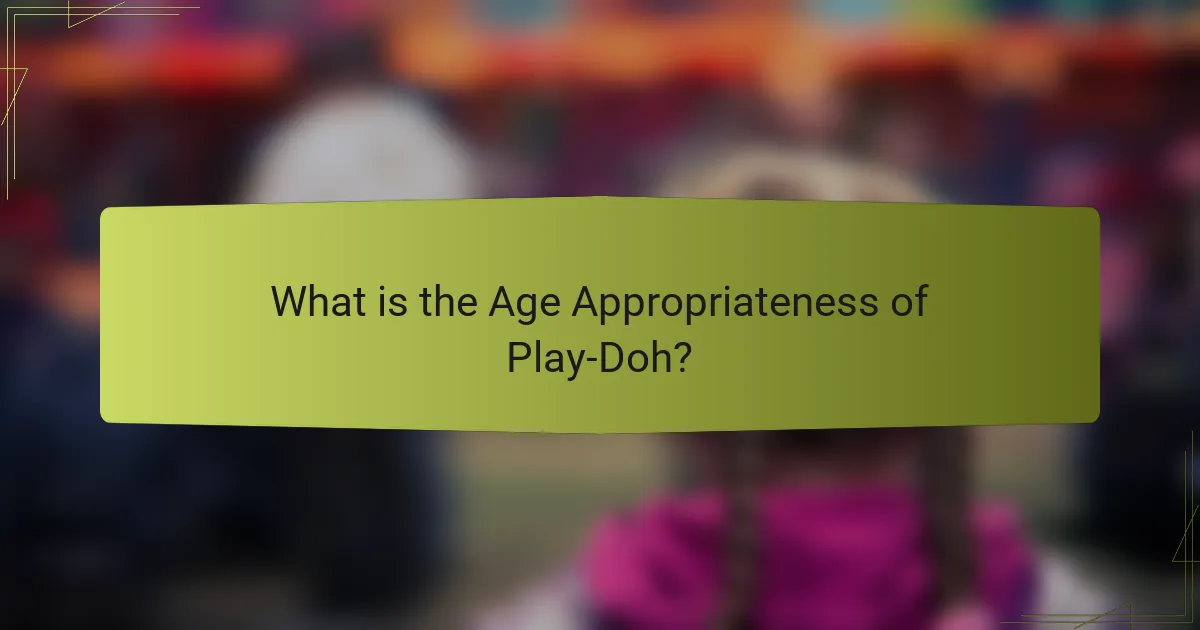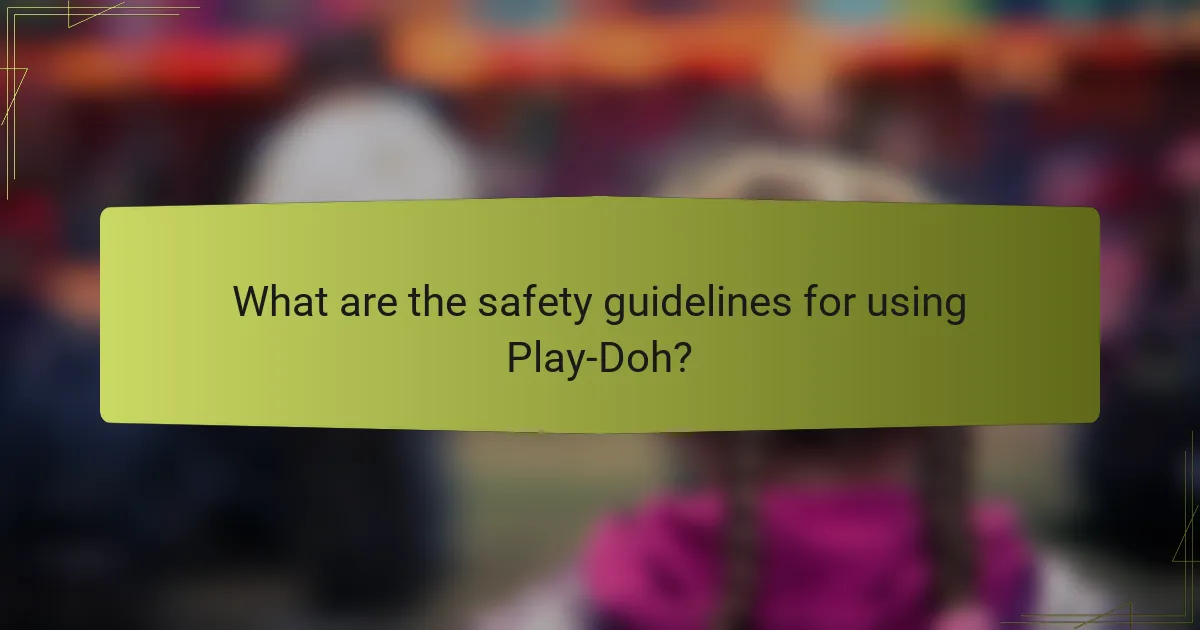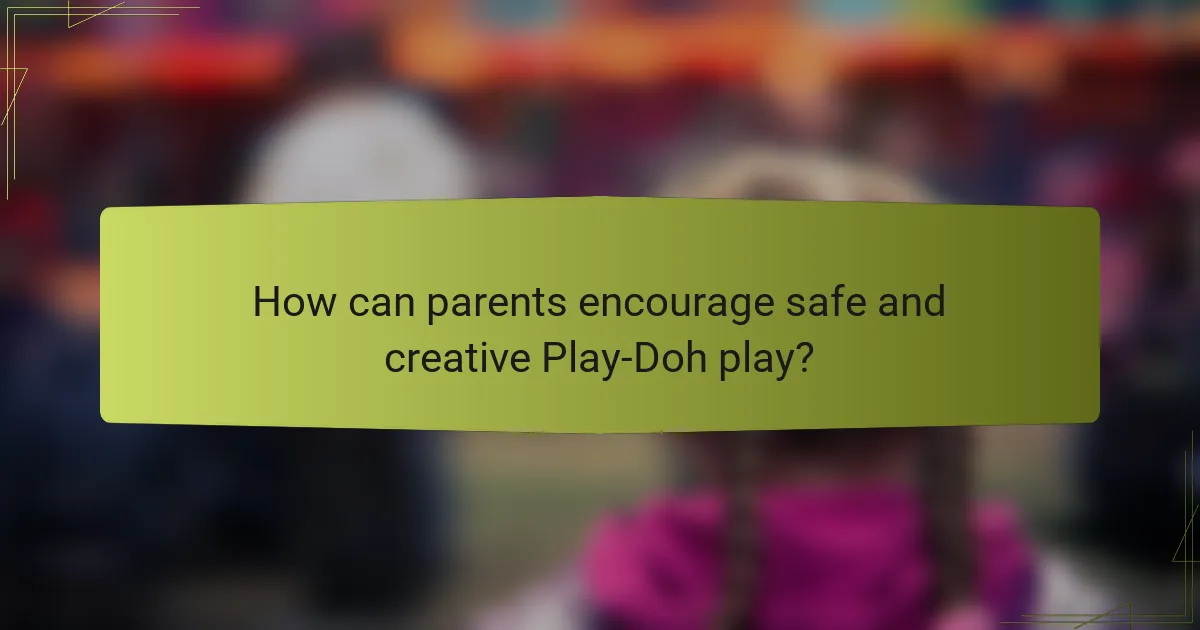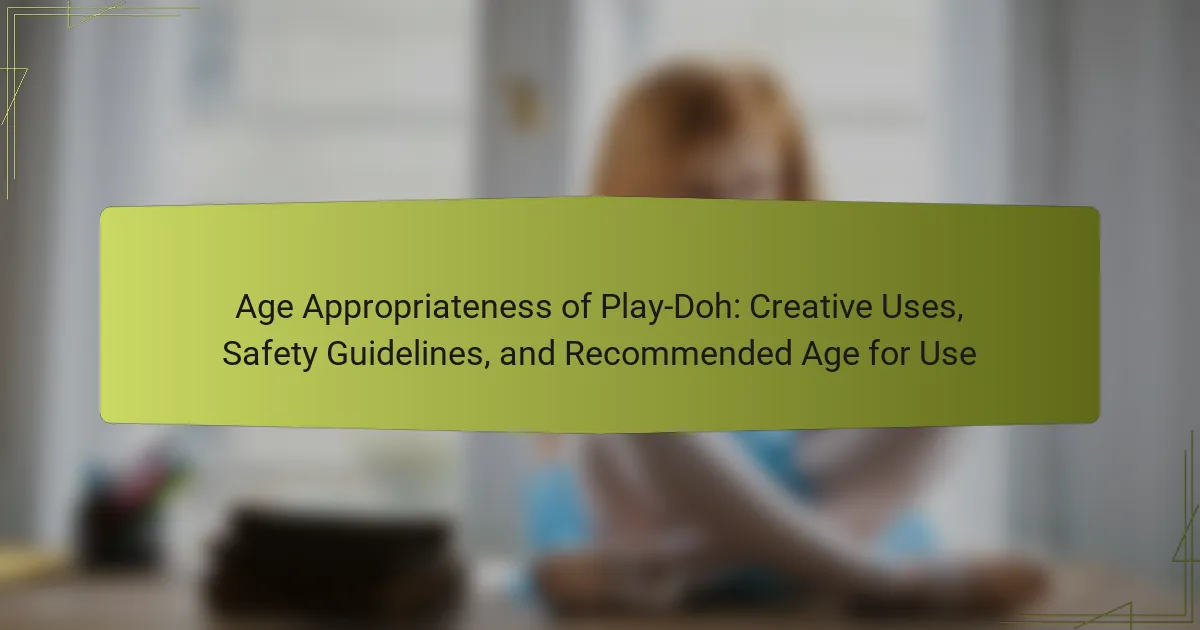Play-Doh is a non-toxic modeling compound designed for children aged 2 and older, promoting creativity and fine motor skills. The article outlines safety guidelines, emphasizing the importance of supervision for children under 3 to prevent ingestion. It discusses the educational benefits of Play-Doh, supported by the American Academy of Pediatrics, and provides practical tips for parents to ensure a safe and engaging play experience. Key recommendations include creating designated play areas, using appropriate tools, and maintaining hygiene during playtime. Overall, Play-Doh serves as a valuable resource for early childhood development when used responsibly.

What is the Age Appropriateness of Play-Doh?
Play-Doh is appropriate for children aged 2 and older. This age recommendation is based on safety guidelines and the product’s design. Play-Doh is non-toxic, making it safe for young children. However, it is essential to supervise children under 3 to prevent ingestion. The texture and malleability of Play-Doh encourage creativity and fine motor skills. Many educational resources support its use for early childhood development. The American Academy of Pediatrics endorses creative play for cognitive growth. Therefore, Play-Doh is a suitable and beneficial activity for toddlers and preschoolers.
Why is age appropriateness important for Play-Doh use?
Age appropriateness is crucial for Play-Doh use to ensure safety and developmental benefits. Children of different ages have varying abilities and needs. Younger children may be prone to putting objects in their mouths, risking choking hazards. Play-Doh formulations can also differ, with some products containing allergens or harmful substances unsuitable for younger users.
Developmentally, age-appropriate Play-Doh activities enhance fine motor skills and creativity. For instance, toddlers benefit from simple squishing and rolling, while older children can engage in more complex sculpting. Research indicates that activities suited to a child’s developmental stage promote engagement and learning (American Academy of Pediatrics, 2018).
Using Play-Doh that matches a child’s age fosters positive experiences and encourages exploration in a safe environment.
What developmental milestones does Play-Doh support in children?
Play-Doh supports several developmental milestones in children. It enhances fine motor skills through activities like rolling, squeezing, and molding. These actions strengthen hand muscles and improve dexterity. Play-Doh also fosters creativity and imagination, allowing children to create various shapes and figures. This imaginative play encourages cognitive development and problem-solving skills. Additionally, it promotes sensory exploration as children engage with different textures and colors. Social skills are also developed during collaborative play, as children share materials and ideas. Overall, Play-Doh is a versatile tool that aids in multiple areas of child development.
How does age affect a child’s interaction with Play-Doh?
Age significantly affects a child’s interaction with Play-Doh. Younger children, typically ages 2 to 4, engage in sensory exploration. They focus on squishing, rolling, and basic shaping. This age group benefits from tactile experiences that enhance motor skills. As children reach ages 4 to 6, they begin to create more complex shapes. They start to understand concepts such as color mixing and basic modeling. Children aged 6 and older often use Play-Doh for imaginative play. They create detailed figures and scenes, reflecting advanced cognitive skills. Research indicates that this progression aligns with developmental milestones in creativity and fine motor skills.
What are the creative uses of Play-Doh for different age groups?
Play-Doh can be creatively used by different age groups in various ways. For toddlers, it serves as a tool for sensory exploration and fine motor skill development. They can squish, roll, and mold it into simple shapes. Preschoolers can engage in imaginative play by creating animals, food items, or characters. This enhances their creativity and storytelling abilities.
For school-age children, Play-Doh can be used for educational purposes. They can model letters, numbers, or even scientific concepts. This makes learning interactive and enjoyable. Teenagers can use Play-Doh for art projects or as a medium for stress relief. They can create intricate designs or sculptures, which can be a form of relaxation.
Each age group benefits from Play-Doh’s versatility. It promotes creativity, fine motor skills, and educational engagement across all developmental stages.
What types of activities can toddlers do with Play-Doh?
Toddlers can engage in various activities with Play-Doh. They can mold shapes and figures using their hands. This helps develop fine motor skills. Toddlers can also use cookie cutters to create different forms. This enhances their creativity and imagination. Rolling the Play-Doh into snakes or balls promotes hand-eye coordination. They can also practice basic counting by making small items. Using tools like rolling pins or plastic scissors can introduce them to more complex tasks. These activities are beneficial for cognitive and physical development.
How can preschoolers enhance their skills using Play-Doh?
Preschoolers can enhance their skills using Play-Doh by engaging in various creative activities. Manipulating Play-Doh improves fine motor skills as children roll, pinch, and shape the dough. These actions strengthen hand muscles and develop coordination. Additionally, Play-Doh encourages imaginative play, allowing preschoolers to create scenarios and characters. This type of play fosters cognitive development and problem-solving skills.
Furthermore, using Play-Doh can enhance language skills. As children describe their creations, they expand their vocabulary and communication abilities. Social skills are also developed when preschoolers collaborate with peers during Play-Doh activities. They learn to share, take turns, and express their ideas. Overall, Play-Doh serves as a versatile tool for skill enhancement in preschool-aged children.
What advanced techniques can older children explore with Play-Doh?
Older children can explore advanced techniques with Play-Doh, such as sculpting, layering, and texturing. Sculpting allows for the creation of detailed figures and structures. Layering involves stacking different colors and shapes to create depth and dimension. Texturing can be achieved using various tools to imprint designs on the surface.
Additionally, older children can experiment with mixed media by incorporating other materials. This could include using beads, fabric, or paper to enhance their Play-Doh creations. Another technique is using molds to create uniform shapes and designs.
These advanced techniques encourage creativity and fine motor skills. Engaging in these activities can also enhance problem-solving abilities. Overall, these methods provide a platform for artistic expression and learning through play.

What are the safety guidelines for using Play-Doh?
Play-Doh is generally safe for children when used according to specific guidelines. Always supervise young children during play to prevent ingestion. Ensure that Play-Doh is kept away from small children who might put it in their mouths. Do not use Play-Doh on surfaces that may be damaged by moisture. Store Play-Doh in a cool, dry place to maintain its quality. If Play-Doh dries out, it should be discarded. Check for any allergic reactions, as some children may be sensitive to its ingredients. Always read the packaging for specific safety instructions. These guidelines help ensure a safe and enjoyable experience with Play-Doh.
What ingredients are in Play-Doh and are they safe for children?
Play-Doh contains flour, water, salt, boric acid, and mineral oil. These ingredients are generally recognized as safe for children. The flour and water form the base of the dough. Salt acts as a preservative. Boric acid is included in small amounts to enhance texture. Mineral oil helps keep the dough moist. According to the American Academy of Pediatrics, Play-Doh is non-toxic and safe for play. However, it is recommended to supervise young children to prevent ingestion.
How can parents identify potential allergens in Play-Doh?
Parents can identify potential allergens in Play-Doh by reviewing the ingredient list on the packaging. Play-Doh typically contains wheat flour, salt, water, and preservatives. Parents should be cautious of common allergens such as gluten, which is found in wheat. Additionally, some formulations may include fragrance or colorants that can trigger allergic reactions. Checking for specific labels indicating “free from” allergens can be helpful. If a child has known allergies, consulting with a pediatrician before use is advisable. Always conduct a patch test by applying a small amount to the child’s skin. This approach helps ensure safety before allowing full use.
What precautions should be taken to ensure safe play with Play-Doh?
Supervision is essential to ensure safe play with Play-Doh. Adults should monitor children during play to prevent ingestion. Play-Doh is non-toxic, but it can still pose a choking hazard. Keep small pieces away from children under three years old. Ensure hands and surfaces are clean before play to avoid contamination. Store Play-Doh in a cool, dry place to maintain its quality. Check for any signs of mold or spoilage before use. Dispose of any Play-Doh that shows these signs. Always follow the manufacturer’s guidelines for safe play.
What age restrictions should be considered when using Play-Doh?
Play-Doh is generally recommended for children aged 2 years and older. This age restriction is due to the potential choking hazard posed by small pieces. Children under 2 may not have the fine motor skills required for safe play. The product packaging often includes age recommendations to ensure safety. Additionally, supervision is advised for younger children during use. This ensures that they do not ingest the material. Many manufacturers provide guidelines based on safety testing for young children. Following these recommendations helps prevent accidents and promotes safe creative play.
What is the recommended minimum age for Play-Doh use?
The recommended minimum age for Play-Doh use is two years old. This age guideline is set to ensure safety and developmental appropriateness. Children under two may have difficulty manipulating the material. They may also be prone to putting small items in their mouths. Play-Doh is non-toxic, but supervision is advised for younger children. The age recommendation is supported by manufacturers and child development experts. This ensures that children can safely enjoy the creative benefits of Play-Doh.
Are there age-specific recommendations for supervision during Play-Doh activities?
Yes, there are age-specific recommendations for supervision during Play-Doh activities. For children aged 2 to 4, close supervision is essential due to the risk of ingestion. At this age, children are still developing fine motor skills and may not fully understand safety guidelines. For children aged 5 to 7, supervision can be more relaxed but should still be present to guide creative play and ensure safety. Children aged 8 and older generally require less supervision, as they can engage in Play-Doh activities independently. These recommendations are supported by child development guidelines that emphasize safety and skill development during play.

How can parents encourage safe and creative Play-Doh play?
Parents can encourage safe and creative Play-Doh play by setting clear boundaries and providing supervision. They should ensure that children use non-toxic Play-Doh to minimize health risks. Parents can create a designated play area to contain mess and enhance focus. Offering various tools, such as cookie cutters and rolling pins, can inspire creativity. Demonstrating different techniques, like molding and sculpting, can spark imaginative ideas. Regularly cleaning the play area and tools promotes hygiene and safety. Engaging with children during playtime fosters a collaborative environment. Research indicates that guided play enhances creativity and learning outcomes in children.
What tips can parents follow for safe Play-Doh play?
Parents should supervise children during Play-Doh play to ensure safety. Supervision helps prevent ingestion of the material. Use non-toxic Play-Doh products to minimize health risks. Store Play-Doh in a cool, dry place to maintain its quality. Encourage hand washing before and after play to promote hygiene. Set boundaries on where Play-Doh can be used to avoid messes. Teach children not to mix Play-Doh with other substances to keep it safe and clean. Regularly check for mold or spoilage to ensure it remains safe for use.
How can parents facilitate creative Play-Doh activities for various age groups?
Parents can facilitate creative Play-Doh activities by tailoring tasks to different age groups. For toddlers, simple tasks like rolling and squishing help develop motor skills. Parents can provide cookie cutters and molds to encourage exploration. For preschoolers, parents can introduce basic shapes and colors. They can guide children in creating animals or objects. For early elementary kids, parents can suggest themed projects like making a favorite character. This age group benefits from more complex tasks that enhance creativity. Research indicates that hands-on activities improve cognitive development in children. Therefore, age-appropriate Play-Doh activities can effectively promote learning and creativity.
What are some common troubleshooting tips for Play-Doh use?
To troubleshoot Play-Doh use, ensure it is fresh and not dried out. Dried Play-Doh can be rehydrated by adding a few drops of water. If Play-Doh is too sticky, dust it lightly with flour to reduce tackiness. For easy molding, warm the Play-Doh in your hands before use. If colors mix undesirably, keep separate containers for different colors. To prevent it from hardening, store Play-Doh in an airtight container. If Play-Doh becomes crumbly, it may need moisture added back in. Always supervise young children during play to ensure safety and prevent ingestion.
The main entity of this article is Play-Doh, a non-toxic modeling compound suitable for children aged 2 and older. The article outlines the age appropriateness of Play-Doh, emphasizing safety guidelines and developmental benefits for different age groups. It discusses how Play-Doh enhances fine motor skills, creativity, and cognitive development, while also detailing specific activities tailored for toddlers, preschoolers, and older children. Additionally, the article provides safety precautions, ingredient information, and tips for parents to facilitate safe and engaging Play-Doh play.
